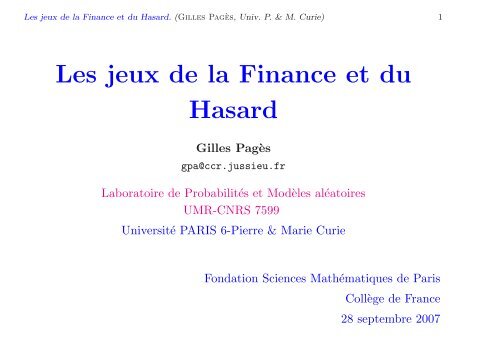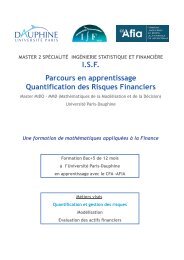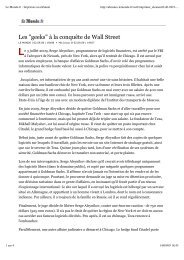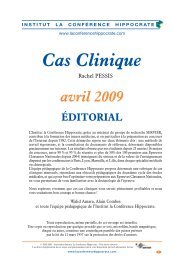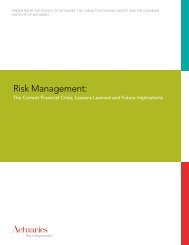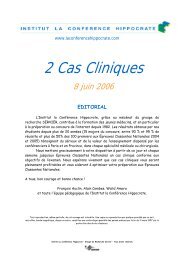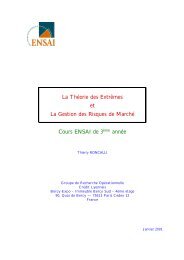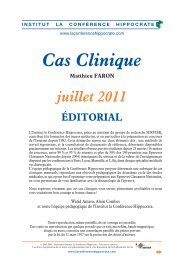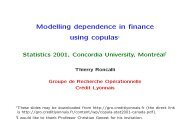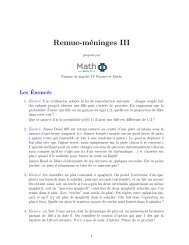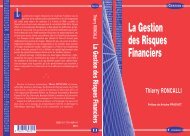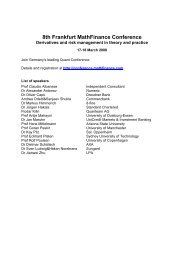Les jeux de la Finance et du Hasard Gilles Pag`es - Maths-fi.com
Les jeux de la Finance et du Hasard Gilles Pag`es - Maths-fi.com
Les jeux de la Finance et du Hasard Gilles Pag`es - Maths-fi.com
You also want an ePaper? Increase the reach of your titles
YUMPU automatically turns print PDFs into web optimized ePapers that Google loves.
<strong>Les</strong> <strong>jeux</strong> <strong>de</strong> <strong>la</strong> <strong>Finance</strong> <strong>et</strong> <strong>du</strong> <strong>Hasard</strong>. (<strong>Gilles</strong> Pagès, Univ. P. & M. Curie) 1<br />
<strong>Les</strong> <strong>jeux</strong> <strong>de</strong> <strong>la</strong> <strong>Finance</strong> <strong>et</strong> <strong>du</strong><br />
<strong>Hasard</strong><br />
<strong>Gilles</strong> Pagès<br />
gpa@ccr.jussieu.fr<br />
Laboratoire <strong>de</strong> Probabilités <strong>et</strong> Modèles aléatoires<br />
UMR-CNRS 7599<br />
Université PARIS 6-Pierre & Marie Curie<br />
Fondation Sciences Mathématiques <strong>de</strong> Paris<br />
Collège <strong>de</strong> France<br />
28 septembre 2007
<strong>Les</strong> <strong>jeux</strong> <strong>de</strong> <strong>la</strong> <strong>Finance</strong> <strong>et</strong> <strong>du</strong> <strong>Hasard</strong>. (<strong>Gilles</strong> Pagès, Univ. P. & M. Curie) 2<br />
<strong>Les</strong> <strong>jeux</strong> <strong>de</strong> l’amour ...<br />
⊲ Il était une fois ... ,unvieux roi fatigué qui vou<strong>la</strong>it marier sa <strong>fi</strong>lle<br />
(Crédit photo Zigomatic)
<strong>Les</strong> <strong>jeux</strong> <strong>de</strong> <strong>la</strong> <strong>Finance</strong> <strong>et</strong> <strong>du</strong> <strong>Hasard</strong>. (<strong>Gilles</strong> Pagès, Univ. P. & M. Curie) 3<br />
⊲ ... qui, elle, nelesouhaitait guère<br />
(Crédit photo Shrek (Dreamworks))
<strong>Les</strong> <strong>jeux</strong> <strong>de</strong> <strong>la</strong> <strong>Finance</strong> <strong>et</strong> <strong>du</strong> <strong>Hasard</strong>. (<strong>Gilles</strong> Pagès, Univ. P. & M. Curie) 4<br />
Le Roi <strong>et</strong> sa <strong>fi</strong>lle conclurent un contrat gré àgré ...<br />
-LaPrincesse recevrait chaque jour l’un <strong>de</strong>s N prétendants <strong>du</strong> royaume.<br />
(Crédit photo Kelblog)
<strong>Les</strong> <strong>jeux</strong> <strong>de</strong> <strong>la</strong> <strong>Finance</strong> <strong>et</strong> <strong>du</strong> <strong>Hasard</strong>. (<strong>Gilles</strong> Pagès, Univ. P. & M. Curie) 5<br />
- Elle aurait une journée pour se faire une opinion par elle-même ...<br />
(Désolé, pas <strong>de</strong> photos ... )
<strong>Les</strong> <strong>jeux</strong> <strong>de</strong> <strong>la</strong> <strong>Finance</strong> <strong>et</strong> <strong>du</strong> <strong>Hasard</strong>. (<strong>Gilles</strong> Pagès, Univ. P. & M. Curie) 6<br />
Quoique ...<br />
(Crédit photo Prince <strong>et</strong> Princesse (Michel Ocelot))
<strong>Les</strong> <strong>jeux</strong> <strong>de</strong> <strong>la</strong> <strong>Finance</strong> <strong>et</strong> <strong>du</strong> <strong>Hasard</strong>. (<strong>Gilles</strong> Pagès, Univ. P. & M. Curie) 7<br />
- Puis elle <strong>de</strong>vrait, soit épouser le prétendant, soit le récuser à jamais, ...<br />
(Crédit photo Gyptis & Protis)
<strong>Les</strong> <strong>jeux</strong> <strong>de</strong> <strong>la</strong> <strong>Finance</strong> <strong>et</strong> <strong>du</strong> <strong>Hasard</strong>. (<strong>Gilles</strong> Pagès, Univ. P. & M. Curie) 8<br />
-Et,leN ème jour, si aucun ne lui convenait ... elle épouserait le<br />
<strong>de</strong>rnier.<br />
(Crédit photo Shrek (Dreamworks))
<strong>Les</strong> <strong>jeux</strong> <strong>de</strong> <strong>la</strong> <strong>Finance</strong> <strong>et</strong> <strong>du</strong> <strong>Hasard</strong>. (<strong>Gilles</strong> Pagès, Univ. P. & M. Curie) 9<br />
⊲ La Princesse a fait un Master 2 <strong>de</strong><br />
Mathématiques <strong>fi</strong>nancières<br />
(avec les vestales <strong>de</strong>s marchés : N. El Karoui, L.<br />
Élie ou H. Geman ou ... )<br />
⊲ Elle y a appris notamment <strong>com</strong>ment<br />
gérer ce contrat <strong>de</strong> façon optimale
<strong>Les</strong> <strong>jeux</strong> <strong>de</strong> <strong>la</strong> <strong>Finance</strong> <strong>et</strong> <strong>du</strong> <strong>Hasard</strong>. (<strong>Gilles</strong> Pagès, Univ. P. & M. Curie) 10<br />
⊲ Modèle (simpliste) <strong>de</strong> prétendants : <strong>Les</strong> prétendants <strong>du</strong> royaume<br />
sont a priori <strong>de</strong>s êtres “i.i.d.” (indépendants, i<strong>de</strong>ntiquement distribués) :<br />
– “indépendants” les uns <strong>de</strong>s autres<br />
– mais “statistiquement analogues”.<br />
Elle va les noter au <strong>fi</strong>l <strong>de</strong>s rencontres. Soit<br />
X k <strong>la</strong> note entre 0 <strong>et</strong> 20 <strong>du</strong> k ème prétendant.<br />
⊲ Le processus “bonheur espéré” (expected happiness) à<strong>la</strong>date k<br />
s’obtient par arbitrage entre le présent <strong>et</strong> ce que l’on sait <strong>du</strong> futur<br />
⎛<br />
⎞<br />
B k = max ⎜<br />
⎝ X k, Approximation <strong>de</strong> B k+1 sachant l’histoire jusqu’en k⎟<br />
} {{ } ⎠<br />
E(B k+1 | histoire k )<br />
B k = max ( X k , Espérance(B k+1 ) ) <strong>et</strong> B N<br />
= X N<br />
.
<strong>Les</strong> <strong>jeux</strong> <strong>de</strong> <strong>la</strong> <strong>Finance</strong> <strong>et</strong> <strong>du</strong> <strong>Hasard</strong>. (<strong>Gilles</strong> Pagès, Univ. P. & M. Curie) 11<br />
⊲ Calcul <strong>du</strong> bonheur moyen atten<strong>du</strong> :Onprocè<strong>de</strong> da façon rétrogra<strong>de</strong><br />
(backward)<br />
EB N<br />
= EX N<br />
=10<br />
<strong>et</strong><br />
<strong>et</strong><br />
E B k = E(max(X k , E(B k+1 ))) =<br />
∫ 20<br />
0<br />
max(x, E(B k+1 ))dx<br />
E B k = 20× ρ N−k , ρ k = 1+ρ2 k+1<br />
2<br />
⊲La stratégie optimale :Dé<strong>fi</strong>nir une règle d’arrêt<br />
,ρ 0 = 1 2 .<br />
θ = min{k : k EB k+1 } ou θ = N (à défaut)<br />
i.e. on s’arrête dès qu’on a trouvé mieux que ce que l’on peut espérer en<br />
moyenne <strong>de</strong>main.
<strong>Les</strong> <strong>jeux</strong> <strong>de</strong> <strong>la</strong> <strong>Finance</strong> <strong>et</strong> <strong>du</strong> <strong>Hasard</strong>. (<strong>Gilles</strong> Pagès, Univ. P. & M. Curie) 12<br />
20<br />
18<br />
16<br />
14<br />
12<br />
10<br />
8<br />
6<br />
4<br />
2<br />
0<br />
0 5 10 15 20 25 30<br />
La Princesse teste 30 pr<strong>et</strong>endants<br />
Fig. 1: Le prétendant n 0 10 a gagné ...
<strong>Les</strong> <strong>jeux</strong> <strong>de</strong> <strong>la</strong> <strong>Finance</strong> <strong>et</strong> <strong>du</strong> <strong>Hasard</strong>. (<strong>Gilles</strong> Pagès, Univ. P. & M. Curie) 13<br />
Au fait<br />
Fig. 2: Sans surprise ...<br />
(Crédit photo P<strong>et</strong>it Prince)<br />
Espérance (θ) ≈ N 3
<strong>Les</strong> <strong>jeux</strong> <strong>de</strong> <strong>la</strong> <strong>Finance</strong> <strong>et</strong> <strong>du</strong> <strong>Hasard</strong>. (<strong>Gilles</strong> Pagès, Univ. P. & M. Curie) 14<br />
La Princesse se marie, mais bientôt elle<br />
s’ennuie ...<br />
Elle s’intéresse aux marchés d’actions ...<br />
Fig. 3: Cours <strong>de</strong> l’action Cogitel <strong>Finance</strong>, k =0,... ,N
<strong>Les</strong> <strong>jeux</strong> <strong>de</strong> <strong>la</strong> <strong>Finance</strong> <strong>et</strong> <strong>du</strong> <strong>Hasard</strong>. (<strong>Gilles</strong> Pagès, Univ. P. & M. Curie) 15<br />
... <strong>et</strong> à leurs dérivés. Anticipant une hausse <strong>de</strong> c<strong>et</strong>te société elle déci<strong>de</strong><br />
d’acquérir une option d’achat sur Cogitel <strong>Finance</strong><br />
Une option américaine ?<br />
Contrat donnant à <strong>la</strong> Princesse le<br />
Droit d’ach<strong>et</strong>er l’action S =(S k ) 0≤k≤N au prix d’exercice K, une <strong>et</strong> une<br />
seule fois entre les dates 0 <strong>et</strong> N.<br />
⊲ La valeur <strong>du</strong> contrat :Par arbitrage entre aujourd’hui <strong>et</strong> <strong>de</strong>main<br />
V k = max ( S k − K, E(V k+1 | histoire jusqu’en k) ) , V N<br />
= max(S N<br />
− K, 0).<br />
⊲ La/une stratégie optimale :<br />
θ := min { k : S k − K ≥ E(V k+1 | histoire jusqu’en k) } ∧ N
<strong>Les</strong> <strong>jeux</strong> <strong>de</strong> <strong>la</strong> <strong>Finance</strong> <strong>et</strong> <strong>du</strong> <strong>Hasard</strong>. (<strong>Gilles</strong> Pagès, Univ. P. & M. Curie) 16<br />
Une option européenne ?<br />
⊲ Contrat donnant à <strong>la</strong> Princesse le<br />
Droit d’ach<strong>et</strong>er l’action S au prix d’exercice K, à<strong>la</strong>date N.<br />
⊲ Pro<strong>fi</strong>t lié à<strong>la</strong>détention <strong>du</strong> contrat en N (payoff) :<br />
⎫<br />
S N<br />
− K si S N<br />
>K ⎬<br />
0 si S N<br />
≤ K ⎭ = max(S N<br />
− K, 0).<br />
V k = E (V k+1 | histoire jusqu’en k) , V N<br />
= max(S N<br />
− K, 0).<br />
– V 0 est <strong>la</strong> prime <strong>de</strong> l’option en 0 (prix déterministe payé par <strong>la</strong> Princesse).
<strong>Les</strong> <strong>jeux</strong> <strong>de</strong> <strong>la</strong> <strong>Finance</strong> <strong>et</strong> <strong>du</strong> <strong>Hasard</strong>. (<strong>Gilles</strong> Pagès, Univ. P. & M. Curie) 17<br />
Qui a ven<strong>du</strong> l’option à <strong>la</strong> Princesse ?<br />
Son banquier (via les analystes quantitatifs qui travaillent pour lui) !<br />
⊲ Comment le banquier a-t-il calculé leprix <strong>de</strong> c<strong>et</strong>te option ?<br />
En gérant un portefeuille <strong>du</strong>pliquant <strong>la</strong> prime <strong>de</strong> l’option sur le marché <strong>de</strong><br />
l’action sous-jacente :<br />
V k − V k−1 = δ k−1 (S k − S k−1 ), k =1,... ,n<br />
où δ k−1 = quantité d’actions détenue en k au vu <strong>du</strong> marché juqu’en k − 1.<br />
max(S N<br />
− K, 0) = V 0 +<br />
N∑<br />
δ k−1 (S k − S k−1 ).<br />
k=1<br />
C’est l’idée <strong>de</strong> <strong>la</strong> gestion (ou “couverture”) dynamique <strong>de</strong> B<strong>la</strong>ck & Scholes.
<strong>Les</strong> <strong>jeux</strong> <strong>de</strong> <strong>la</strong> <strong>Finance</strong> <strong>et</strong> <strong>du</strong> <strong>Hasard</strong>. (<strong>Gilles</strong> Pagès, Univ. P. & M. Curie) 18<br />
⊲ Si (S k ) 0≤k≤N est une martingale i.e. un modèle <strong>de</strong> fortune dans un jeu<br />
équitable<br />
alors<br />
E(S k − S k−1 | histoire jusqu’en k − 1) = 0<br />
δ k−1 = E((V k − V k−1 )(S k − S k−1 ) | histoire jusqu’en k)<br />
.<br />
E((S k − S k−1 ) 2 | histoire jusqu’en k)
<strong>Les</strong> <strong>jeux</strong> <strong>de</strong> <strong>la</strong> <strong>Finance</strong> <strong>et</strong> <strong>du</strong> <strong>Hasard</strong>. (<strong>Gilles</strong> Pagès, Univ. P. & M. Curie) 19<br />
⊲Idée <strong>de</strong> B<strong>la</strong>ck & Scholes :<br />
Choisir une “probabilité-martingale” P ∗ ≠<strong>la</strong>“vraie” probabilité historique P.<br />
Un marché où c<strong>et</strong>te probabilité existe <strong>et</strong> est unique est dit “<strong>com</strong>pl<strong>et</strong>”.<br />
Théorème.(Harrisson, Kreps, Pliska) (a) Dans un marché oùiln’yapas<br />
d’arbitrage possible, il existe une “probabilité-martingale” (<strong>com</strong>patible avec le<br />
réel).<br />
(b) Dans un marché <strong>com</strong>pl<strong>et</strong> où <strong>la</strong>“probabilité-martingale” (<strong>com</strong>patible avec<br />
le réel) est unique toutes les options peuvent être <strong>du</strong>pliquées avec l’actif<br />
risqué.
<strong>Les</strong> <strong>jeux</strong> <strong>de</strong> <strong>la</strong> <strong>Finance</strong> <strong>et</strong> <strong>du</strong> <strong>Hasard</strong>. (<strong>Gilles</strong> Pagès, Univ. P. & M. Curie) 20<br />
Et en temps continu ...<br />
⊲ Le mouvement brownien ... géométrique entre 0 <strong>et</strong> T<br />
dS t = S t (µdt+ σdW t )<br />
(calcul stochastiqued ′ Ito)<br />
⇐⇒<br />
S t = s 0 e − σ2<br />
2 T +σW T .<br />
⊲ Formule <strong>de</strong> B<strong>la</strong>ck & Scholes (1973)<br />
Prime BS<br />
0 = s 0 N<br />
(<br />
log(s0 /K)+ σ2<br />
2 T<br />
σ √ T<br />
)<br />
− KN<br />
(<br />
log(s0 /K) − σ2<br />
2 T<br />
σ √ T<br />
)<br />
Couverture en t :<br />
δ BS<br />
t<br />
= N<br />
(<br />
log(St /K)+ σ2<br />
2<br />
(T − t)<br />
σ √ T − t<br />
)<br />
N (x) =<br />
∫ x<br />
e − ξ2 2<br />
dξ<br />
√<br />
2π<br />
,<br />
fonction <strong>de</strong> répartition <strong>de</strong> <strong>la</strong> loi normale.<br />
∞
<strong>Les</strong> <strong>jeux</strong> <strong>de</strong> <strong>la</strong> <strong>Finance</strong> <strong>et</strong> <strong>du</strong> <strong>Hasard</strong>. (<strong>Gilles</strong> Pagès, Univ. P. & M. Curie) 21<br />
Et en temps continu ...<br />
⊲ Le mouvement brownien ... géométrique entre 0 <strong>et</strong> T<br />
dS t = S t σdW t<br />
(calcul stochastiqued ′ Ito)<br />
⇐⇒<br />
S t = s 0 e − σ2<br />
2 T +σW T .<br />
⊲ Formule <strong>de</strong> B<strong>la</strong>ck & Scholes (1973)<br />
Prime BS<br />
0 = s 0 N<br />
(<br />
log(s0 /K)+ σ2<br />
2 T<br />
σ √ T<br />
)<br />
− KN<br />
(<br />
log(s0 /K) − σ2<br />
2 T<br />
σ √ T<br />
)<br />
Couverture en t :<br />
δ BS<br />
t<br />
= N<br />
(<br />
log(St /K)+ σ2<br />
2<br />
(T − t)<br />
σ √ T − t<br />
)<br />
N (x) =<br />
∫ x<br />
e − ξ2 2<br />
dξ<br />
√<br />
2π<br />
,<br />
fonction <strong>de</strong> répartition <strong>de</strong> <strong>la</strong> loi normale.<br />
∞
<strong>Les</strong> <strong>jeux</strong> <strong>de</strong> <strong>la</strong> <strong>Finance</strong> <strong>et</strong> <strong>du</strong> <strong>Hasard</strong>. (<strong>Gilles</strong> Pagès, Univ. P. & M. Curie) 22<br />
C t = c(T-t, x)<br />
(x – K)+<br />
valeur-temps<br />
valeur intrinsèque<br />
0<br />
K<br />
x<br />
Fig. 4: Prime <strong>de</strong> l’option d’achat Cogitel <strong>Finance</strong>, k =0,... ,N
<strong>Les</strong> <strong>jeux</strong> <strong>de</strong> <strong>la</strong> <strong>Finance</strong> <strong>et</strong> <strong>du</strong> <strong>Hasard</strong>. (<strong>Gilles</strong> Pagès, Univ. P. & M. Curie) 23<br />
Aux <strong>de</strong>rnières nouvelles, <strong>la</strong> Princesse ...<br />
a trouvé unposte <strong>de</strong> Quant à<strong>la</strong>City (Londres).<br />
Comme 60% <strong>de</strong> nos étudiants en Master <strong>de</strong> Mathématiques <strong>fi</strong>nancières.<br />
Elle espère ainsi gagner assez d’argent pour renflouer ...<br />
son vieux pays en état <strong>de</strong> faillite.
<strong>Les</strong> <strong>jeux</strong> <strong>de</strong> <strong>la</strong> <strong>Finance</strong> <strong>et</strong> <strong>du</strong> <strong>Hasard</strong>. (<strong>Gilles</strong> Pagès, Univ. P. & M. Curie) 24<br />
Remerciements<br />
Merci à Julie P., à Cogitel F. <strong>et</strong> aux créateurs <strong>de</strong> :<br />
– Gyptis & Protis,<br />
– P<strong>et</strong>it Prince,<br />
– Prince <strong>et</strong> Princesse,<br />
– Shrek (2 fois).<br />
<strong>et</strong> <strong>de</strong><br />
– Zigomatic.


